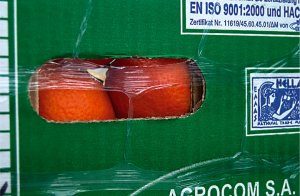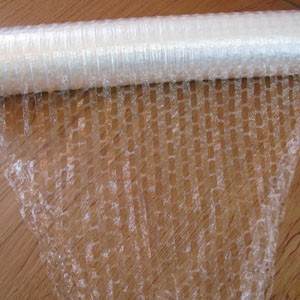
***Updated 5-24-18
What's the best stretch film for the food industry? GOOD QUESTION. Luckily for you, we've got you covered. Vented stretch films come to mind, specifically Air-Flow stretch wrap.
So what's the deal with this film?
 This stretch film has die cut holes for increased ventilation. The ventilation will help reduce spoiling of food that can normally happen with regular stretch film. It does this by reducing the condensation inside the pallet wrap. Protecting fresh food, hot food, and frozen food on a pallet is crucial to the shipping and receiving of all food companies.
This stretch film has die cut holes for increased ventilation. The ventilation will help reduce spoiling of food that can normally happen with regular stretch film. It does this by reducing the condensation inside the pallet wrap. Protecting fresh food, hot food, and frozen food on a pallet is crucial to the shipping and receiving of all food companies.
Secondly, it comes in both hand and machine grades. Some operations may be smaller and only require a hand wrapping process. Other processes with large operations and pallets should require machine grade stretch wrap. That's OK, it comes in both so you're covered either way.
Third, Air-Flow helps with multiple types of products. For frozen food products it will shorten the freezing time. The colder air will come through the product faster because of the ventilation. Another added bonus is that the de-frosting time will be shorter. Moisture will be able to escape the product faster. Hotter products will benefit from this stretch film as well. Air-Flow helps prevent condensation from building up. No more bad performing glues and labels falling off with this film. Don't forget about those fresh foods and plants. Improved air circulation is the main reason they'll be fresher, even longer.
I don't work in the food industry, why does this matter to me?
Alright so you're not in the exact industry, how about the following?
- Beverage
- Meat
- Plant and Flowers
- Produce
- Fish
- Pet Food
- Farm
- Medical
Show me a real example of this film working.
Did you really think I was going to end without giving you a case study to really show you the benefits of this film?
Problem: A were stacking individual cartons into pallet loads while the cream was still between 68 - 86 degrees. These pallets were wrapped using regular stretch film and placed into blast chillers. These chillers would go for two hours until the cream reached a temperature of 41 degrees. Once the right temperature was reached, they removed the film and the individual cartons were shrink wrapped into multiple product units.
Can you guess what happened?
Yeah, this process wasn't really working. They were then placing the items back into chillers to cool it down again. Waiting until the temperature was again 41 degrees, and then stretch wrapped once more before shipment. Seems like a lot of extra work and cooling, and re-cooling right?
Solution: We explained to them the benefits of our vented films. This now meant that they only chilled their products for one hour, cutting their time in half. Their product line became less congested, improving their production volumes at the same time. 100% in fact, now that's a substantial improvement. Oh yeah, there was another added production savings too. Their products were being permanently aerated due to the vented stretch wrap. That meant that the load could even be cooled during transit.
Ready for more??

Perfect! That's what we're here for. Now it's time to check out our selection of vented films and give us a call for a quote or any questions you may still have.
*Editors note. This post was originally published on December 13, 2017 and has been updated with the most up to date content.
Follow our Knowledge Base for the latest blogs on packaging supplies, equipment, case studies, and more ways to save money.
Don't forget to follow us on LinkedIn, Twitter, and Facebook and click those share buttons below if this post helped you.







